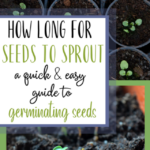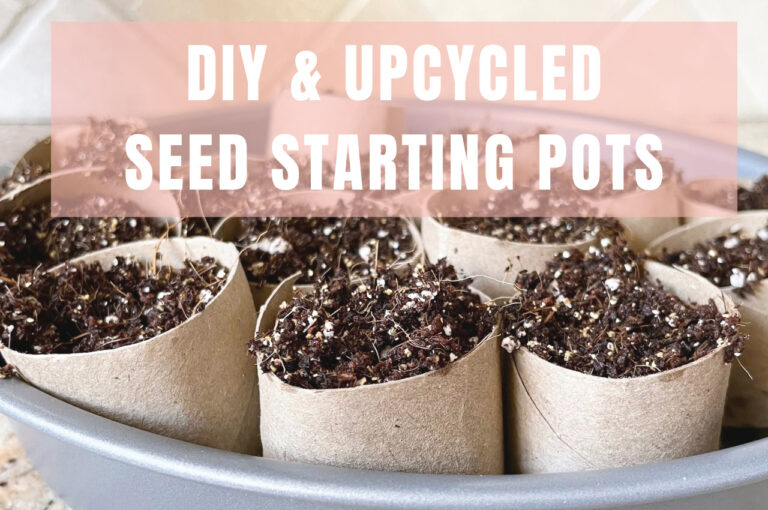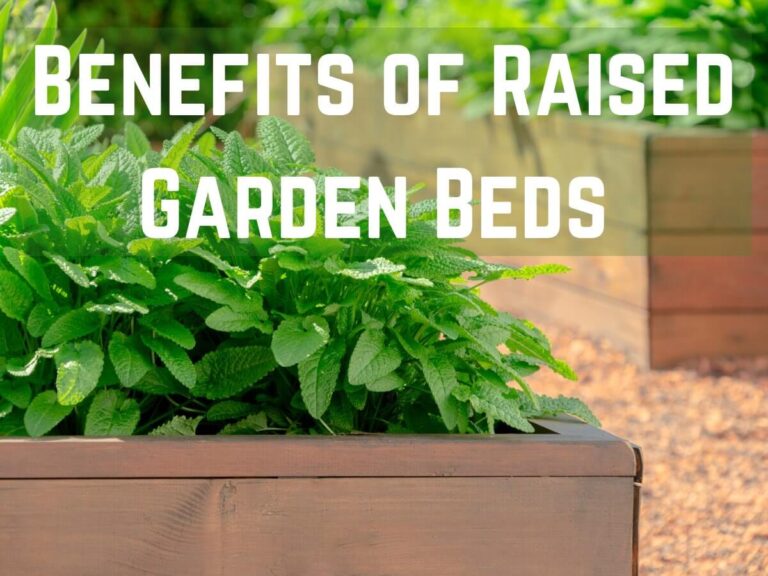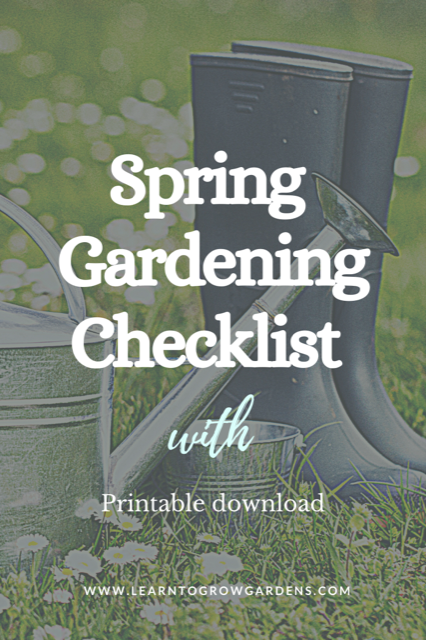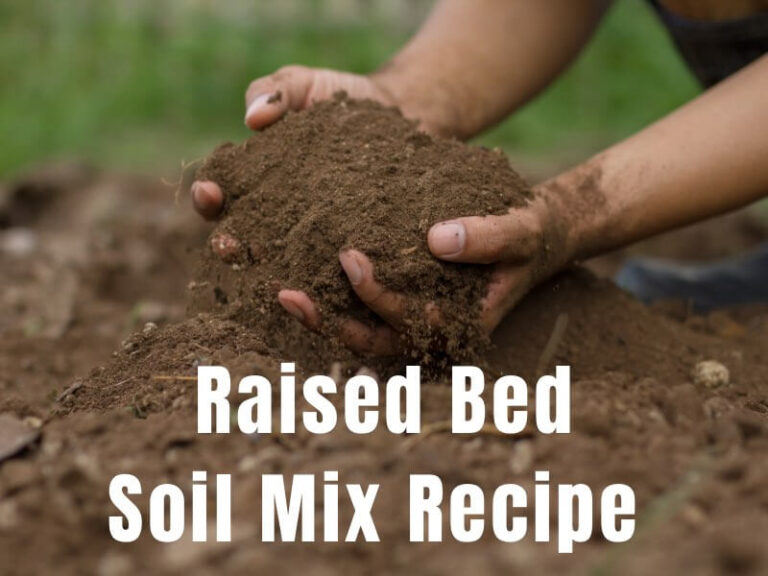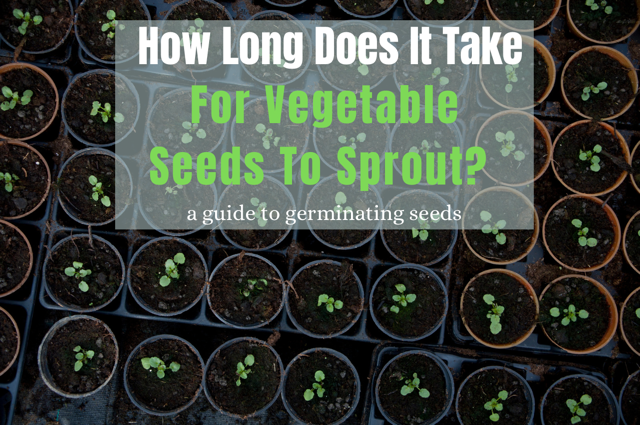
How Long Does It Take For Vegetable Seeds To Sprout
(This post is about sprouting vegetable seeds, but the information here also applies to most flower, herb and plant seeds.)
It’s no secret that starting vegetables from seed is a great way to save some money. Every year, I expand my seed collection and learn to start new plants from seed. I grow many different vegetables throughout the year, so starting things from seed for my vegetable garden makes the most sense. I can start seeds when I need to, grow new and favorite varieties and save money doing so.
One thing I wish I had known from the start is just how long it takes for vegetable seeds to sprout (the other thing I wish I had known is that seeds last a long time. Like, years. I’ve thrown so many away thinking they were expired!)
Last year, I ordered a rare but promising variety of bell pepper. When the packet arrived, it held just 10 small seeds. I carefully planted them up and waited. And waited. And waited. Finally, after 2 weeks I gave up and planted something else.
Did you know that some peppers can take 3 weeks to sprout? *insert sad face*
Had I known this at the time, I would have continued babying my seed trays, hoping for my peppers to push through the seed starting mix.
There is so much to learn in gardening! Fortunately, the basics are pretty easy, and the rest can be learned over time. My hope is to help you with what I’ve learned, and help you become a better gardener!
On that note, let’s discuss how long it takes vegetable seeds to sprout, how we can hurry up the process, and what we can do to improve germination.
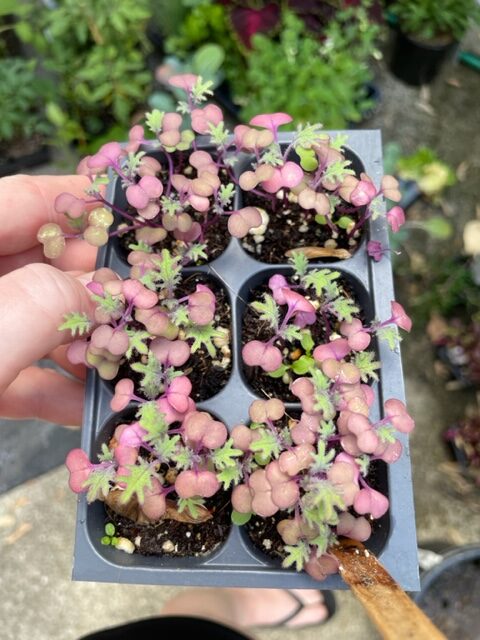
This post contains affiliate links. You can read my full disclosure policy here.
What can affect the germination rate of vegetable seeds?
There are several factors that can affect the germination rate of seeds, including light, soil temperature and moisture, the viability of the seeds, and the oxygenation of the soil.
Let’s break each one down a little bit.
How does light affect germination?
While most seeds will germinate regardless of light, that is not true of all seeds. Some seeds prefer to germinate in complete darkness, while others require light to germinate. This information can usually be found right on the seed packet.
All seeds require light right after germination, and should be moved to a light source as soon as they break through the soil. If they don’t receive adequate light after germinating, they will become “leggy” as they reach for the light. This leads to weaker stems, and a weaker plant overall.
How does soil temperature affect germination?
Most seeds germinate somewhere between 50°-85°, depending on the variety. Any warmer or cooler than their ideal temperature and a series of chemical reactions that need to take place will be done too fast or too slow.
These chemical reactions help the seed take in water, breaking down the outer seed coat, and telling the seed it’s time to start growing. If this doesn’t happen the right way, at the right speed, the seed won’t germinate.
Again, the ideal temperature for germination can usually be found in the seed packet. A general rule of thumb, though, is that cool season vegetables germinate at cooler temperatures than hot season vegetables. Spinach, for example, prefers to germinate in temps ranging 45°-68°, while heat loving peppers prefer temps ranging 75°-85°.
Warmer temperatures can also cause soil mixes to dry out much quicker. “When a seed dries out, it dies out.” It’s important to keep your seeds from overheating.
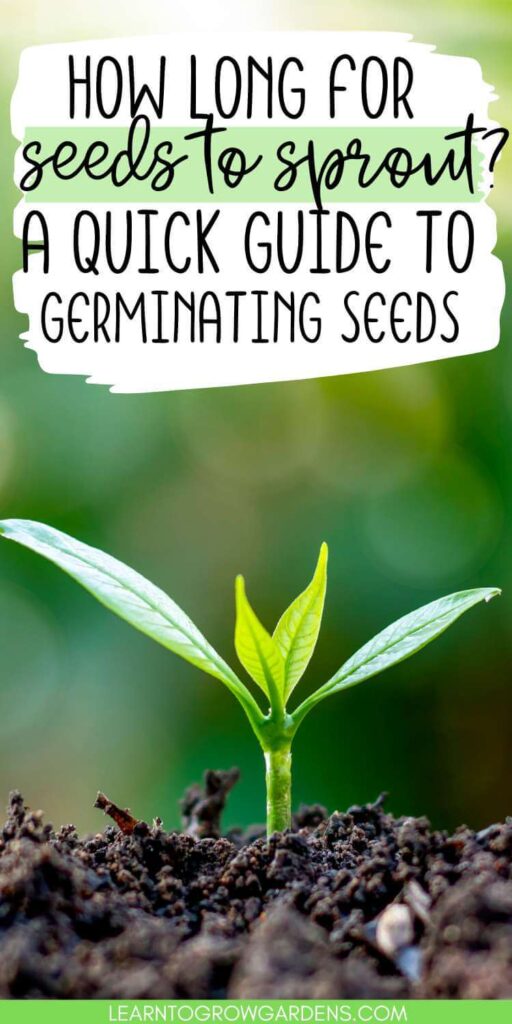
How does moisture affect seed germination?
Moisture is a very important factor in germinating seeds. Too little moisture and seeds won’t sprout, too much and they rot. The right amount of water available in the soil is a key factor to successful germination.
So how much moisture do seeds need? And how do you know they’re getting the right amount?
One way is to sprout your seeds on a damp paper towel or coffee filter in a plastic bag. You can find out how to sprout seeds using the paper towel method here.
If starting seeds in a soilless mix, make sure it’s damp, but not wet, when you plant your seeds. You don’t want any dry bits of mix, and your trays should not be dripping. If it’s too wet, allow the soilless mix to dry out before planting your seeds. If it’s too dry, add more water until it’s thoroughly damp. Seeds need evenly moist soil.
Once you’ve planted your seeds in the mix, place a dome over the top to hold moisture inside until after germination. If you don’t have a dome, mist your seeds with a water bottle every day. Keep a close eye on them. If the surface seems to be drying out between waterings, increase to twice a day.
What is seed viability? And how does seed viability affect germination?
Seed viability is the likelihood of a dormant seed to sprout under ideal conditions. Seed viability decreases as a seed ages, or if it’s stored improperly.
Some seeds have a short window in which they’re viable, regardless of how they are stored. Onion and parsnip seeds are typically good for one year under ideal conditions. After a year, the chances of germination drops significantly and fresh seed should be used.
Thankfully, a lot of seeds have a much larger window and can last for several years. Even so, seed viability diminishes as the seeds age or if their environment is less than ideal. A sprout test using the baggy method can help you check for viability in old seeds.
Seed viability is an important factor in germination because even under ideal conditions, seeds with low viability may fail to sprout or will produce subpar adult plants that succumb to pests and diseases.
The best way to check for viable seeds is to sprout 10 seeds with the paper towel method. After the average germination time for those seeds have passed, count how many seeds have germinated and multiply by 10. This will give you the germination rate. Seeds with less than 30% germination should be composted and new seeds should be purchased.
How does the oxygenation of soil affect the germination of seeds?
Seeds require oxygen in the surrounding soil in order to germinate. They use this oxygen to produce energy for the germination and growth cycles. Oxygen can be reduced by the presence of too much water in the soil, compacted soil, or hard surfaces.
Without sufficient oxygen, seeds cannot perform aerobic respiration, turning stored energy into glucose. Without sufficient oxygen, our seeds will basically starve to death, because they will be unable to use the stored energy inside to complete germination and initial growth.
When germinating seeds, be sure the soil surrounding them is damp, but not wet. We want our seeds to have access to water, to help soften the outer shell coating, but not so much water that they aren’t getting enough oxygen and eventually rot.
Another way to increase oxygen for our seeds is to soak them in a solution of hydrogen peroxide. Hydrogen peroxide is basically water with an extra molecule of oxygen, and the bond between the two oxygen atoms is weak. Using hydrogen peroxide for seeds, or in various uses around the garden, can supply our seeds and plants with additional oxygen.
Soaking seeds in hydrogen peroxide before planting helps weaken the outer shell coating, and allowing the seed to take in more oxygen. It’s estimated that soaking seeds in a weakened hydrogen peroxide solution can increase germination by 15%!
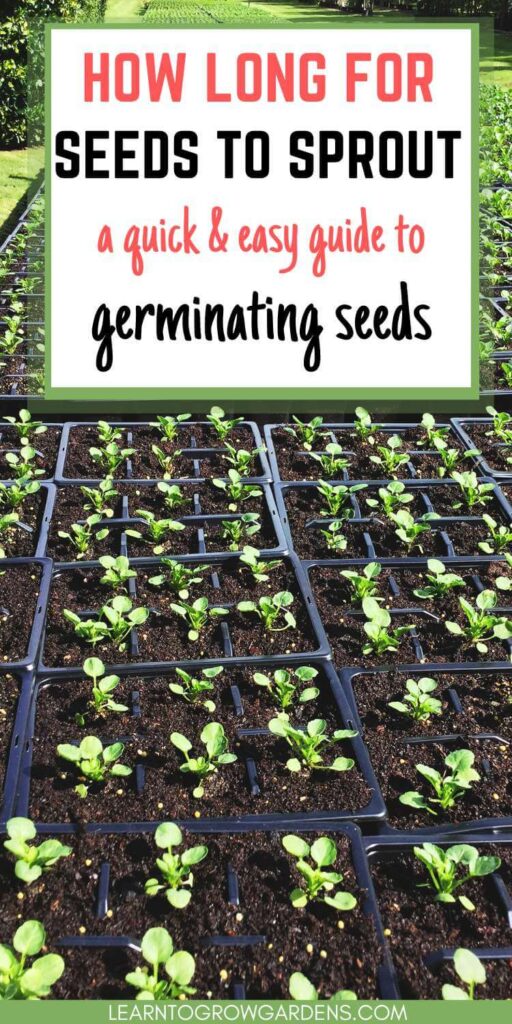
How to soak seeds in hydrogen peroxide to increase germination
- Create a diluted solution of 1 tsp hydrogen peroxide to one cup water.
- Separate your seeds by type into little cups or bowls.
- Pour the diluted hydrogen peroxide solution over your seeds until they are completely submerged.
- Soak your seeds in this solution for 8-24 hours.
- After soaking, rinse with fresh water and plant as usual.
Bonus tip: This same hydrogen peroxide solution can be used to treat root rot in potted plants by soaking roots for 6 hours and then repotting in fresh soil. You can also treat fungal diseases by spraying the affected foliage with the hydrogen peroxide solution, using up to 4tsp hydrogen peroxide per pint in a spray bottle.
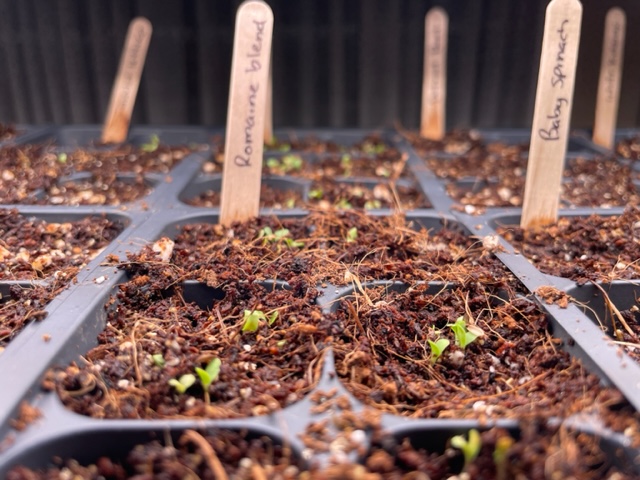
How long does it take for vegetable seeds to sprout
So, how long does it take for vegetable seeds to sprout, in average conditions? That depends on the seeds.
It takes an average of one to two weeks for most vegetable seeds to sprout. Radishes are one of the quickest, sprouting in just 3 days, while parsley is amongst the longest, requiring up to 24 days to germinate. Most seeds will germinate within 2-4 weeks.
Under optimal conditions, the following type of seed have approximate germination times of:
3-5 days:
- Beets
- Broccoli
- Brussels sprouts
- Cabbage
- Cauliflower
- Cucumbers
- Kale
- Kohlrabi
- Lettuce
- Muskmelon
- Pumpkin
- Radish
- Rutabaga
- Spinach
- Squash
- Sweet corn
- Swiss chard
- Turnip
- Watermelon
6-10 days
- Lima bean
- Snap bean
- Carrots
- Celery
- Eggplant
- Endive
- Leek
- Okra
- Onion
- Pea
- Pepper
- Tomato
11-20 days:
- Celeriac
- Parsley
- Parsnip
Related:
Free Printable Seed Starting Chart
Where to buy quality vegetable seeds
When planting vegetables from seed, the quality of the seed goes a long way in how successful you are in both germination and quality of plants. There are many seed companies out there, but they’re not all worth your hard earned dollars.
I’ve included links to some of my favorite seed companies. These are companies I have personally ordered from and had success with. I choose these companies for a variety of reasons, which include the quality of seeds, price, and seed varieties available.
Some of my favorite vegetable seed companies are:
You can also find seeds at your local garden center, home improvement store, and even your favorite grocery store.
FAQ
How long does it take for seeds to sprout indoors?
Germinating seeds indoors is the opportunity to provide ideal conditions for your seeds. If conditions are right, you can expect seeds to sprout on the lower end of the average seed germination time.
How long does it take for flower seeds to sprout?
Under ideal conditions, flower seeds will typically sprout within one to two weeks.
What vegetable seeds sprout the fastest?
Seeds from the cabbage family, such as broccoli, cauliflower and kale, along with radishes and lettuces, are quick to sprout. You can expect to see sprouts emerge in as little as 3 days.
How do you speed up the germination of seeds?
To speed up the germination of seeds, we recommend germinating seeds in paper towel. This method creates an ideal environment for seeds, and will speed up germination and increase the viability of your seeds.
Can seeds still germinate after two weeks?
Most seeds will germinate within 2-3 weeks under ideal conditions. If your seeds aren’t sprouting, check to be sure they are given adequate warmth, moisture, and light. After one month, any seeds that haven’t germinated should be discarded.
Why are my vegetable seeds not sprouting?
Seeds will only germinate under ideal conditions. They need the right amount of light, warmth, moisture, and oxygen. Check to be sure your seeds are fresh, and the conditions are ideal for sprouting. You can also remove a few seeds and try germinating them in paper towel, to be sure they are viable.
What is the best mixture for starting seeds?
We have a post for creating your own DIY seed-starting mix! We also recommend a few seed-starting mixes that can be found on Amazon.
How long do tomato seeds take to germinate?
Tomato seeds germinate in 5 to 10 days under optimal conditions. When planting tomato seeds, it’s important to provide warm soil that’s evenly moist. This can be done with a heat mat or warm room. Once tomato seeds have sprouted, provide adequate lighting an inch or two above the sprouts.
As an Amazon Associate, I earn from qualifying purchases.


